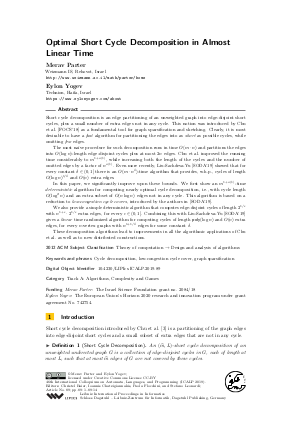Optimal Short Cycle Decomposition in Almost Linear Time
Authors Merav Parter, Eylon Yogev
-
Part of:
Volume:
46th International Colloquium on Automata, Languages, and Programming (ICALP 2019)
Part of: Series: Leibniz International Proceedings in Informatics (LIPIcs)
Part of: Conference: International Colloquium on Automata, Languages, and Programming (ICALP) - License:
 Creative Commons Attribution 3.0 Unported license
Creative Commons Attribution 3.0 Unported license
- Publication Date: 2019-07-04
File

PDF
LIPIcs.ICALP.2019.89.pdf
- Filesize: 0.56 MB
- 14 pages
Document Identifiers
Subject Classification
ACM Subject Classification
- Theory of computation → Design and analysis of algorithms
Keywords
- Cycle decomposition
- low-congestion cycle cover
- graph sparsification
Metrics
- Access Statistics
-
Total Accesses (updated on a weekly basis)
0Document
0Metadata
Abstract
Short cycle decomposition is an edge partitioning of an unweighted graph into edge-disjoint short cycles, plus a small number of extra edges not in any cycle. This notion was introduced by Chu et al. [FOCS'18] as a fundamental tool for graph sparsification and sketching. Clearly, it is most desirable to have a fast algorithm for partitioning the edges into as short as possible cycles, while omitting few edges.
The most naïve procedure for such decomposition runs in time O(m * n) and partitions the edges into O(log n)-length edge-disjoint cycles plus at most 2n edges. Chu et al. improved the running time considerably to m^{1+o(1)}, while increasing both the length of the cycles and the number of omitted edges by a factor of n^{o(1)}. Even more recently, Liu-Sachdeva-Yu [SODA'19] showed that for every constant delta in (0,1] there is an O(m * n^{delta})-time algorithm that provides, w.h.p., cycles of length O(log n)^{1/delta} and O(n) extra edges.
In this paper, we significantly improve upon these bounds. We first show an m^{1+o(1)}-time deterministic algorithm for computing nearly optimal cycle decomposition, i.e., with cycle length O(log^2 n) and an extra subset of O(n log n) edges not in any cycle. This algorithm is based on a reduction to low-congestion cycle covers, introduced by the authors in [SODA'19].
We also provide a simple deterministic algorithm that computes edge-disjoint cycles of length 2^{1/epsilon} with n^{1+epsilon}* 2^{1/epsilon} extra edges, for every epsilon in (0,1]. Combining this with Liu-Sachdeva-Yu [SODA'19] gives a linear time randomized algorithm for computing cycles of length poly(log n) and O(n) extra edges, for every n-vertex graphs with n^{1+1/delta} edges for some constant delta.
These decomposition algorithms lead to improvements in all the algorithmic applications of Chu et al. as well as to new distributed constructions.
Cite As Get BibTex
Merav Parter and Eylon Yogev. Optimal Short Cycle Decomposition in Almost Linear Time. In 46th International Colloquium on Automata, Languages, and Programming (ICALP 2019). Leibniz International Proceedings in Informatics (LIPIcs), Volume 132, pp. 89:1-89:14, Schloss Dagstuhl – Leibniz-Zentrum für Informatik (2019)
https://doi.org/10.4230/LIPIcs.ICALP.2019.89
BibTex
@InProceedings{parter_et_al:LIPIcs.ICALP.2019.89,
author = {Parter, Merav and Yogev, Eylon},
title = {{Optimal Short Cycle Decomposition in Almost Linear Time}},
booktitle = {46th International Colloquium on Automata, Languages, and Programming (ICALP 2019)},
pages = {89:1--89:14},
series = {Leibniz International Proceedings in Informatics (LIPIcs)},
ISBN = {978-3-95977-109-2},
ISSN = {1868-8969},
year = {2019},
volume = {132},
editor = {Baier, Christel and Chatzigiannakis, Ioannis and Flocchini, Paola and Leonardi, Stefano},
publisher = {Schloss Dagstuhl -- Leibniz-Zentrum f{\"u}r Informatik},
address = {Dagstuhl, Germany},
URL = {https://drops.dagstuhl.de/entities/document/10.4230/LIPIcs.ICALP.2019.89},
URN = {urn:nbn:de:0030-drops-106653},
doi = {10.4230/LIPIcs.ICALP.2019.89},
annote = {Keywords: Cycle decomposition, low-congestion cycle cover, graph sparsification}
}
Author Details
Funding
- Parter, Merav: The Israel Science Foundation grant no. 2084/18
- Yogev, Eylon: The European Union's Horizon 2020 research and innovation program under grant agreement No. 742754.
References
-
Alexandr Andoni, Jiecao Chen, Robert Krauthgamer, Bo Qin, David P Woodruff, and Qin Zhang. On sketching quadratic forms. In Proceedings of the 2016 ACM Conference on Innovations in Theoretical Computer Science, pages 311-319. ACM, 2016.

-
Joshua Batson, Daniel A Spielman, and Nikhil Srivastava. Twice-ramanujan sparsifiers. SIAM Journal on Computing, 41(6):1704-1721, 2012.

-
Timothy Chu, Yu Gao, Richard Peng, Sushant Sachdeva, Saurabh Sawlani, and Junxing Wang. Graph Sparsification, Spectral Sketches, and Faster Resistance Computation, via Short Cycle Decompositions. In 59th Annual Symposium on Foundations of Computer Science, FOCS. IEEE Computer Society, 2018.

-
Michael Dinitz, Robert Krauthgamer, and Tal Wagner. Towards Resistance Sparsifiers. In Approximation, Randomization, and Combinatorial Optimization. Algorithms and Techniques, APPROX/RANDOM 2015, August 24-26, 2015, Princeton, NJ, USA, pages 738-755, 2015.

-
David Durfee, John Peebles, Richard Peng, and Anup B Rao. Determinant-preserving sparsification of SDDM matrices with applications to counting and sampling spanning trees. In Foundations of Computer Science (FOCS), 2017 IEEE 58th Annual Symposium on, pages 926-937. IEEE, 2017.

-
Alon Itai and Michael Rodeh. Covering a graph by circuits. In International Colloquium on Automata, Languages, and Programming, pages 289-299. Springer, 1978.

-
Arun Jambulapati and Aaron Sidford. Efficient n/ε Spectral Sketches for the Laplacian and its Pseudoinverse. In Proceedings of the Twenty-Ninth Annual ACM-SIAM Symposium on Discrete Algorithms, pages 2487-2503. SIAM, 2018.

-
Yang P. Liu, Sushant Sachdeva, and Zejun Yu. Short Cycles via Low-Diameter Decompositions. SODA, 2019.

-
Michael Luby. A simple parallel algorithm for the maximal independent set problem. SIAM journal on computing, 15(4):1036-1053, 1986.

-
Merav Parter and Eylon Yogev. Distributed Computing Made Secure: A Graph Theoreric Approach. SODA, 2019.

-
Merav Parter and Eylon Yogev. Low Congestion Cycle Covers and Their Applications. SODA, 2019.

-
David Peleg. Distributed Computing: A Locality-sensitive Approach. SIAM, 2000.

-
Daniel A Spielman and Shang-Hua Teng. Nearly-linear time algorithms for graph partitioning, graph sparsification, and solving linear systems. In Proceedings of the thirty-sixth annual ACM symposium on Theory of computing, pages 81-90. ACM, 2004.

